 That's pretty much all the fame and fortune that the most powerful (and expensive) single high energy physics experiment in history has received. I'm not going to go into the whole history or controversy surrounding the amazing new atom smasher (I love that phrase!) down by Geneva, LHC. But rather to relate the events at the Large Hadron Collider to some of my own experiences working at the Stanford Linear Accelerator Center -- SLAC. Everyone's favorite string theorist, Brian Greene, wrote a wonderful piece for the New York Times that better explains the search for the Higgs and the whole tiny-black-hole scare way better than I could.
That's pretty much all the fame and fortune that the most powerful (and expensive) single high energy physics experiment in history has received. I'm not going to go into the whole history or controversy surrounding the amazing new atom smasher (I love that phrase!) down by Geneva, LHC. But rather to relate the events at the Large Hadron Collider to some of my own experiences working at the Stanford Linear Accelerator Center -- SLAC. Everyone's favorite string theorist, Brian Greene, wrote a wonderful piece for the New York Times that better explains the search for the Higgs and the whole tiny-black-hole scare way better than I could.My time at SLAC, to move on, is one of those crazy things on my resume that has, unfortunately, rolled off below the fold and so I don't get to talk about it at job interviews anymore. Along with my time at Amazon, my time at SLAC has the feel of being part of something more than my immediate job. At one, we changed the way people looked at business and commerce. At another, we added to the depth of our understanding of the universe.
 Whereas at Amazon we may all have been acolytes following the word of The Bezos, at SLAC we were all acolytes performing arcane rituals of devotion and sacrifice to a multi-mile long vacuum filled tube and a collection of magnets, giant RF amplifiers called klystrons, and the associated cast of power supplies, measuring systems, controls, pumps, and all the rest. Electrons were hurled down the pipe, hammered along my enormous amounts of radio energy, looped through a heart-shaped half-circle and slammed into a corresponding beam of their antimatter counterparts, positrons. When these teensy particles are accelerated, thanks to some clever connections in the fundamental ground rules of the universe, they actually increase in mass/energy. So the resulting collision released an enormous amount of energy -- and in all kinds of interesting particles. A massive cryogenically cooled detector could track these heavyweight fragments and provide data on their behavior.
Whereas at Amazon we may all have been acolytes following the word of The Bezos, at SLAC we were all acolytes performing arcane rituals of devotion and sacrifice to a multi-mile long vacuum filled tube and a collection of magnets, giant RF amplifiers called klystrons, and the associated cast of power supplies, measuring systems, controls, pumps, and all the rest. Electrons were hurled down the pipe, hammered along my enormous amounts of radio energy, looped through a heart-shaped half-circle and slammed into a corresponding beam of their antimatter counterparts, positrons. When these teensy particles are accelerated, thanks to some clever connections in the fundamental ground rules of the universe, they actually increase in mass/energy. So the resulting collision released an enormous amount of energy -- and in all kinds of interesting particles. A massive cryogenically cooled detector could track these heavyweight fragments and provide data on their behavior.These behaviors served to confirm, refute, or inspire the work of theorists. Science works (in theory) like this: a phenomena is observed. Scientists devise a theory that explains the cause and behavior of the phenomena. Scientists use this theory to predict some as-yet-unseen phenomena. Experimenters then go looking for this new phenomena to verify the veracity of the theory -- or to force a re-examination.
At SLAC, we were poking at some odd asymmetries in particle production. Simple theory says that at the point of the creation of the universe -- the big bang -- equal numbers of "conventional" and "anti-matter" particles should have been produced. Anti-matter is nothing like as weird as they make it sound in Star Trek. Any given particle just has the opposite charge of its normal partner (incidentally, this means there are no anti-neutrons). And if examples of the two ever meet, they annihilate each other in a total conversion of mass into energy, but that's no big deal. When we talk about "massive" amounts of energy we are talking about massive for the scale of the objects colliding. SLAC collisions produced less energy than the impact of a settling grain of dust. LHC collisions are on par with two mosquitos ramming each other head on.
Remember Churchill's classic quote that Russia was an enigma wrapped inside a mystery wrapped inside a pierogi or something like that? SLAC was much the same way -- though the wrappings were not nearly so clear cut or tasty.
The old 1960's vintage technology has been updated countless times in 40 years of physics life. And when I say "updated" I don't necessarily mean "replaced." When I was working there, at a facility merely thirty years old, traces of the original control system remained. Buried in a dusty room somewhere was the original control console for the two mile linac. The console was dusty too -- but an amazing artifact of that era of engineering that I find so fascinating. Entirely electromechanical it had some absolutely crazy things going on -- one that I remember was a series of potentiometers (knobs) about 2/3 of an inch around that had the readout gauge for some corresponding parameter built into the face of the knob. My undergraduate brain marveled (and still does marvel) at the complexity of creating such a system. No touch-screen-and-slider back then...
But back to this console, it a dusty room. It was a big room, stacked with semi-discarded gear, and the console had been shoved over to one side of it, pretty much out of the way. But it was clearly still active -- several fat bundles of cable came out of the back and snaked across the short distance from floor to wall. Turns out that when the SLAC control system had been updated as part of the SLD project (or perhaps sooner) the hadn't actually replaced the old control system. They'd just spliced the new computerized system onto it. This control panel was still active! Inputs came in to it from the computerized system and then back out again to actually run the system.
I pictured the machine running something like this: engineer makes parameter changes on a DEC Station or whatever kind of UNIX boxes we were using for the front end. That uses our 10BASE2 Ethernet to talk to the big VAX 11/780 that was sitting in a glass-paneled room in the Main Control Center looking very much like the WOPR from Wargames. That communicates by some arcane variable voltage or pulse counting analogue signal to the mysterious control console which passively relays the engineer's request out to the actual magnet or power supply or pulse generator.
From what I remember, that old console's gone now, junked alongside the SAGE consoles and all the other detritus of 1960's engineering. And SLAC is undoubtedly better for it: more reliable, simpler, and easier to keep running.
But the point is that that old machine was a living thing. And I'm not talking about the mutant cockroaches that would sometimes call up from the higher rad parts of the beamline. The machine was moody, irritable, frustrating, and occasionally satisfying. When people in the Sacramento Valley turned on their air conditioners in the summer and our power supply wiggled about, parameters on the machine would start to waiver and falter. When large trucks drove by (or for that matter tiny earthquakes -- we were a more sensitive seismograph than anything the USGS possessed) the beam would waver. Actually the beam didn't waver -- it kept going still -- the machine wavered around it.
My point is that we needn't expect the universe to end anytime soon. I'm sure that CERN has, with the LHC, put together an extremely well engineered and carefully planned machine. One that will, I hope, suffer from few of the artifacts of kluging that beset SLAC. That said, the LHC does rely on the existing SPS for initial acceleration, but in a much less critically integrated way. Instead I'm sure they will face the challenges typical of an entirely new system -- challenges of converting the theory and plan of operation in to practice.
 At SLAC that moment finally happened late one night when an operator off the late shift decided to experiment with some beam parameters in an unconventional way. For months the LEP collider (footnote -- the LHC is built in the tunnel originally constructed for LEP) had been providing a good deal more luminosity than us -- working in the same energy range but producing a LOT more collisions. Particle physics is, to a very great extent, a statistical science and it takes a good sample of behaviors to understand how you need to plot the graph. Our individual collisions produced cleaner data, but they were winning in a quantity-over-quality fight.
At SLAC that moment finally happened late one night when an operator off the late shift decided to experiment with some beam parameters in an unconventional way. For months the LEP collider (footnote -- the LHC is built in the tunnel originally constructed for LEP) had been providing a good deal more luminosity than us -- working in the same energy range but producing a LOT more collisions. Particle physics is, to a very great extent, a statistical science and it takes a good sample of behaviors to understand how you need to plot the graph. Our individual collisions produced cleaner data, but they were winning in a quantity-over-quality fight.We'd been struggling to get the machine to do what it was supposed to be doing. On paper, our luminosity figures were good enough to return some really nice science -- but reality wasn't corresponding with paper. I don't remember the exact story anymore, but for some reason, one night, this operator had an excuse to get a little creative with the settings on our two-mile-plus electron gun. She tweaked things in a way that I recall being, in retrospect, very intuitive but entirely opposite of the "party line" for how the thing was supposed to be set up. Suddenly we got a spike in collisions and the luminosity figures were trending towards what they were supposed to (and needed to) be.
From nightshift operator to hero, in just a few key parameters.
I'm sure that LHC will have its similar moments where you realize that either the individual protons or antiprotons aren't quite doing what you thought they would (and wrangling protons offers a whole host of different challenges from electrons). Or moments where it is realized that the phenomenally complex system of machine and detectors interacts in ways that no one quite expected them to.
In the meantime, I hope that the ignorant doom-criers will take a break. I understand that the ethereal reaches of physics are neither easily comprehensible nor of immediate appeal. But I find the fact that every single article I've read on the LHC startup has focused on the fringe element's efforts to spread fear or to shut the project down.
People repeat the overused phrase "God particle" like physicist are either a bunch of blaspheming heretics or else expect Yahweh to a appear over the CERN campus near Geneva in all of his billowing-cloud Old Testament wrath. People talk about the whole black-hole thing in a way that implies their only knowledge of a black hole is from the Disney movie and that they expect Maximillian Schell and a homicidal robot to pop out of the beams and start sucking the entire planet, Anthony Perkins, Earnest Borgnine, and all, to their doom.
To get slightly political, I find this yet another symptom of a creeping acceptance of ignorant mediocrity that has spread to the point that we, at least in this nation, appear to consider flawed normality more valuable and noble than educated eloquence. This anti-intellectualism may well be a globally creeping trend, for all I know, and the anti-LHC ranters are certainly not confined to this nation and much of the outcry over the "Deep Impact" comet probe arose from outside our borders.
But this is all beside the point -- if you've been reading this for any time you know my feelings about the conservatism of space exploration (read the New Horizons blog!) and pursuit of "safe" solutions rather than ones that run the risk of producing dramatic advances.
I want to end on a cheerful and optimistic note so, as I wrap up, let me say this. To all the scientists and engineers at CERN, now the undisputed world center of experimental high-energy physics, I have to tip my hat for your perseverance in getting this thing built and wish you the best of luck in getting it tuned up, fully operational, and producing vital science. I'm very curious to see the results start coming out and, even more, to see Brian Greene write another book about it!

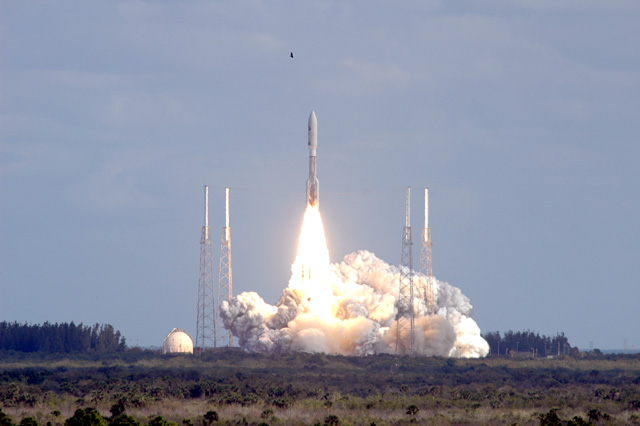
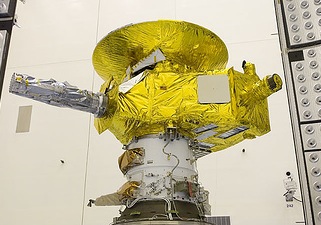
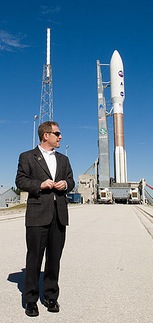
 Launching from Kennedy, at 28 degrees North, provides a boost of 450 meters per second -- about 5% of our total rule-of-thumb velocity increment. For a hypothetical rocket I've been doodling out in the form of a Numbers spreadsheet, this works out to a payload (to low Earth orbit) launching from KSC allows the payload to increase from 7000kg (for a mythical zero-velocity launch site) to 8500kg! This happens for no increased launch vehicle mass, no increased cost, just a willingness to put up with a few hurricanes.
Launching from Kennedy, at 28 degrees North, provides a boost of 450 meters per second -- about 5% of our total rule-of-thumb velocity increment. For a hypothetical rocket I've been doodling out in the form of a Numbers spreadsheet, this works out to a payload (to low Earth orbit) launching from KSC allows the payload to increase from 7000kg (for a mythical zero-velocity launch site) to 8500kg! This happens for no increased launch vehicle mass, no increased cost, just a willingness to put up with a few hurricanes.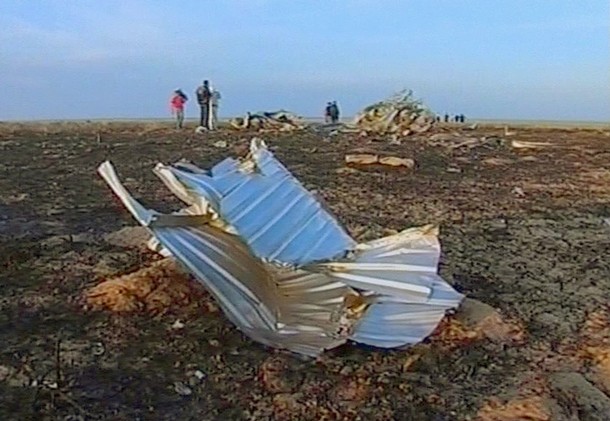 For starters, look at Russia. Devoid of a "space safe" site to the East (almost any Russian East coast launch site would have to fly over Japan), they are forced to launch from the West side of the nation, taking advantage of the vast reaches of emptiness that fill the middle part of Russia. This approach isn't without very serious drawbacks -- spent 1st stages from Russian Proton launchers litter the steppes of Kazakhstan. The toxic traces of the NTO/UDMH propellant that Proton uses have begun leaching into the groundwater supplies with, well, predictable results.
For starters, look at Russia. Devoid of a "space safe" site to the East (almost any Russian East coast launch site would have to fly over Japan), they are forced to launch from the West side of the nation, taking advantage of the vast reaches of emptiness that fill the middle part of Russia. This approach isn't without very serious drawbacks -- spent 1st stages from Russian Proton launchers litter the steppes of Kazakhstan. The toxic traces of the NTO/UDMH propellant that Proton uses have begun leaching into the groundwater supplies with, well, predictable results.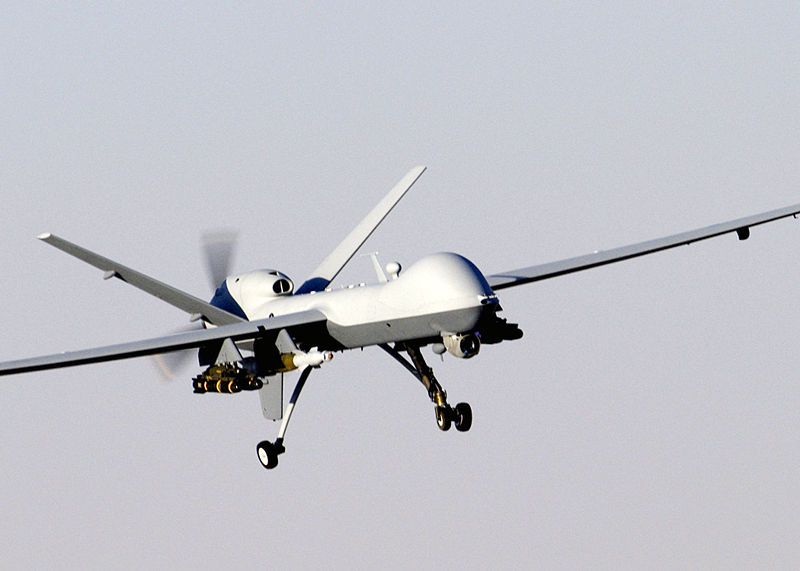 The first thing that got these musings started was an article in Aviation Week that a
The first thing that got these musings started was an article in Aviation Week that a  Never the less, this illustrates one of the projected directions of modern air war. Un-crewed (we don't say "unmanned" any more) air vehicles have the wonderful ability to stay on scene for hours and hours and hours -- days even. A Reaper can loiter for NN hours, a Global Hawk for 40 to 48, and that latter figure after flying a 3,000nm round trip from home field to target area. This kind of sustained presence is invaluable in brining the areal perspective to the kind of fight going on in Iraq and Afghanistan. The traditional fast mover can offer little but responsive firepower -- heading in from a loitering point when called for by guys on the ground and depending on them for direction and guidance. Even maintaining that kind of ability -- a "cab rank" of close air support -- requires a couple of dozen aircraft in the field, tankers, and a rotating (and expensive) presence.
Never the less, this illustrates one of the projected directions of modern air war. Un-crewed (we don't say "unmanned" any more) air vehicles have the wonderful ability to stay on scene for hours and hours and hours -- days even. A Reaper can loiter for NN hours, a Global Hawk for 40 to 48, and that latter figure after flying a 3,000nm round trip from home field to target area. This kind of sustained presence is invaluable in brining the areal perspective to the kind of fight going on in Iraq and Afghanistan. The traditional fast mover can offer little but responsive firepower -- heading in from a loitering point when called for by guys on the ground and depending on them for direction and guidance. Even maintaining that kind of ability -- a "cab rank" of close air support -- requires a couple of dozen aircraft in the field, tankers, and a rotating (and expensive) presence. Only the guy-with-rifle can clear a stairwell without blowing up the building. Only the guy-with-rifle can rifle through the papers in a bomb-maker's hide looking for contacts. Only the guy-with-rifle can snap interconnected zip-ties across someone's wrists and send him back across the lines. Only the guy-with-rifle can man a roadblock or walk the streets on a dismounted patrol. Only the guy-with-rifle can use his wits and his skill in their purest form to go, see, and report with an intimacy with which no sensor package can compete. And, in the nicer side of the military, only the man-with-rifle can put down that gun and unload supplies or build schools or clear rubble or help the wounded or any of those humanitarian moments.
Only the guy-with-rifle can clear a stairwell without blowing up the building. Only the guy-with-rifle can rifle through the papers in a bomb-maker's hide looking for contacts. Only the guy-with-rifle can snap interconnected zip-ties across someone's wrists and send him back across the lines. Only the guy-with-rifle can man a roadblock or walk the streets on a dismounted patrol. Only the guy-with-rifle can use his wits and his skill in their purest form to go, see, and report with an intimacy with which no sensor package can compete. And, in the nicer side of the military, only the man-with-rifle can put down that gun and unload supplies or build schools or clear rubble or help the wounded or any of those humanitarian moments.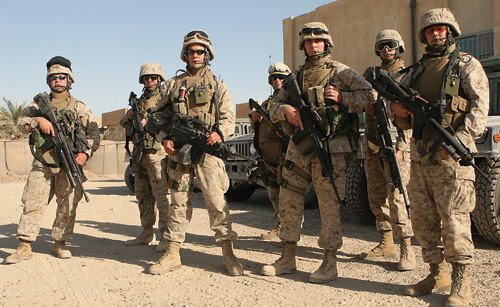 Any given guy-with-rifle might now carry a personal radio and GPS receiver, a laser rangefinder, night vision gear, and a short range guided missile -- all gear inconceivable as personal equipment even twenty years ago. His rifle might have a laser spot projector for nighttime target marking, a flashlight, a grenade launcher, and a 4-power scope clamped and strapped to it. He may wear protective gear offering protection unheard of to previous generations of soldiers. But all of this goes to underscore not his budding obsolescence at the hands of impending robotic marvels but rather continued -- or even increased -- importance.
Any given guy-with-rifle might now carry a personal radio and GPS receiver, a laser rangefinder, night vision gear, and a short range guided missile -- all gear inconceivable as personal equipment even twenty years ago. His rifle might have a laser spot projector for nighttime target marking, a flashlight, a grenade launcher, and a 4-power scope clamped and strapped to it. He may wear protective gear offering protection unheard of to previous generations of soldiers. But all of this goes to underscore not his budding obsolescence at the hands of impending robotic marvels but rather continued -- or even increased -- importance. All of this makes one thing clear -- the rifleman is here to stay. The reasons for this emphasis shift are obvious -- increasing expectation of urban fighting, prevalance of counter-insurgency fighting, peacekeeping operations where forces work close to the civilian populations rather than in an open field battle -- are obvious and clear to anyone who watches the news. Tanks are retreating from their role as the unstoppable bohemouth's of the battlefield back to the role of supplying escort, protection, and covering fire for the infantry for which they were originally concieved. Air power is threatening to obsolete itself, metamorphosing (at least partially) from resplendant knights of the air into remote control spotters sitting in air-conditioned control vans thousands of miles from conflict.
All of this makes one thing clear -- the rifleman is here to stay. The reasons for this emphasis shift are obvious -- increasing expectation of urban fighting, prevalance of counter-insurgency fighting, peacekeeping operations where forces work close to the civilian populations rather than in an open field battle -- are obvious and clear to anyone who watches the news. Tanks are retreating from their role as the unstoppable bohemouth's of the battlefield back to the role of supplying escort, protection, and covering fire for the infantry for which they were originally concieved. Air power is threatening to obsolete itself, metamorphosing (at least partially) from resplendant knights of the air into remote control spotters sitting in air-conditioned control vans thousands of miles from conflict.